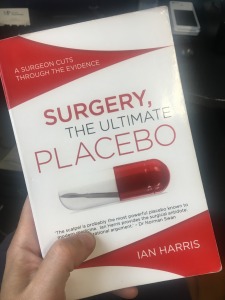“For many complaints and conditions, the benefits from surgery are lower, and the risks higher than you or your surgeon may think”.
-Ian Harris
Thankfully it is edging ever closer to holiday time for us. The downside to being involved with team sport is the unpredictability of the season. Hence holidays get put on hold. The plus side to a late summer holiday is warmer weather and some much needed catch up time with family. Every year I’ll pack a book, maybe two, with the hope that somewhere in between sand castle sculpting (and smashing), perfecting our bomb dives, and endless ice-cream I might grab a moment to myself. With three small chaps for company it seldom happens obviously and a couple of chapters into any book is my record to date. I’m struggling to find something to match the heights of last years endeavor: Surgery, The Ultimate Placebo by Ian Harris – an attention grabbing title for me with stories that delve into the placebo effect and surgery, a genuinely mind blowing and powerful concept. And although in keeping with previous holidays completion rate I found myself getting through this one quicker than most…once back from holidays.

So is there any truth in the title? The most common surgical procedure I encounter in clinic is knee arthroscopy. You may know it as “a clean out”, “wash out”, or “key hole surgery”. It is indeed the most researched surgical procedure with many randomised control trials, some investigating the effectiveness of knee arthroscopy compared with sham surgery. In other words they have compared a procedure whereby the surgeon will (i) cut open the knee joint, repair or remove an area of damage and stitch it back up again, or (ii) cut open the knee joint, have a little look, do absolutely nothing, and stitch it back up again. So what might you expect the outcomes of this to be? The group that had surgery improved by 30%. So surgery does indeed work, at least a bit. But what about the other group? Surely doing nothing would make no difference to that persons problem, knee pain in this instance. Well the thing is they also improved a little bit, by 30%, the same amount as the surgical group (Sihvonen et al 2015).
Despite sham surgery similarly effective in reducing pain why do we continue with surgery?? That’s quite the leap of faith right there, especially for only a 30% reduction in pain. Not to mention the well established risks associated with surgery: blood clots, increased incidence of future knee osteoarthritis and ultimately further more invasive surgery down the line. Then there is the cost which amounts to $4 billion annually for partial menisectomy alone, quite an outgoing for any health service. So there must be some other way. Surely with advances in medicine there is a more up to date method to address common knee pain; a less invasive, cheaper alternative. Could such an intervention exist? Step forward my old friend. Ladies and gentlemen it is with great pleasure I introduce to you (not for the first time in these blogs), exercise.
But let’s play fair here. We’ve scrutinised surgery a little thus far so lets put exercise to the test in similar fashion. Kise et al (2016) looked at various outcomes, not just pain, while investigating the effectiveness of arthroscopic surgery versus a 12 week (3 times per week) supervised rehabilitation program for middle aged patients with degenerative meniscal tears. They found no significant difference between outcomes. So in keeping with previous studies exercise improved pain but only just as much as surgery, minus a fancy little scar. But interestingly (and obviously) the exercise group improved their knee strength after the 12 week program compared to the surgical group who were weaker and continued to be for up to 1 year after surgery. This increase in knee strength allowed the exercise group to be more physically active which would have been the main incentive to address their knee pain in the first place, this physical activity just further improving their condition.
There is really strong evidence for conservative management of many knee joint injuries, some would even recommend against surgery and associate it with harm for middle aged or older patients with degeneration (Thorlund et al 2015). Yet despite this I still sometimes have a really hard time convincing people to go down the exercise route. My views may come across as biased but it is not without evidence. As a society we want a quicker fix, or what we think is the quick fix for absolutely everything: We want to lose weight; get faster or stronger; progress in our careers; meet Mr or Ms Perfect online, and we want it NOW. These all take time, patience, planning and commitment. Let’s not gloss over it: it takes hard work. Overcoming injury is no different. So with the cost of one patients knee arthroscopy the equivalent of managing 8 patients conservatively with exercise therapy I sign this off in a Trainspotting-esque, to-the-point John Hodge fashion (less the swearing).
Choose exercise. Choose improved pain. Choose less clicking, clunking and locking in the knee when moving about. Choose improved cartilage quality and improved physical activity levels. Choose not having your knee cut open and risking infection or other post operative risks. Choose other ways to spend your hard earned cash. Choose lower health insurance premiums globally when they finally cop on that these interventions aren’t being cost effective compared to alternatives. Choose a bit of muscle soreness the day after your exercise program because that’s just normal. Choose treating 26 other chronic conditions and preventing another 35 simultaneously while you’re at it. Choose your future. Choose exercise.
For more information on any of the issues addressed throughout this article please contact Rob via email at mccabephysiotherapy@gmail.com, Twitter @mccabephysio, Facebook at McCabe Physiotherapy or visit http://www.mccabephysiotherapy.com
Rob McCabe MISCP
Chartered Physiotherapist
Orchard House, Moorefield Rd, Newbridge, Co. Kildare
